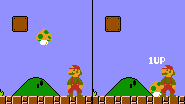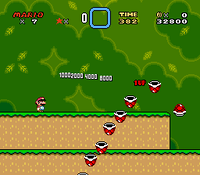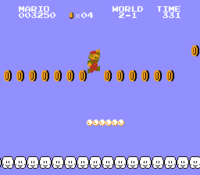Extra life
- This article is about the number of retries the player is given throughout the game, sometimes referred to as "1-Up". For other uses of the term "1-Up", see 1-Up.
| It has been suggested that this page be split into 1-Up Cloud. (discuss) |

An extra life, also known as a 1-up (alternatively 1-Up, 1-UP, 1UP, or 1up) or Life Up, is a mechanic used in video games, especially platformers, such as those in the Super Mario franchise. A 1-up awards the player an extra chance to beat the game. If a player loses a life, they are able to start from the beginning of the level (or sometimes at the level's checkpoint, if it has been reached) without losing a significant amount of progress. When a player loses all of their lives, a Game Over results, and the game must either be played again from the beginning or be restarted from the last save point.
Players can lose lives by being defeated by an enemy; falling into hazards such as pits, lava, and poison; getting crushed by an obstacle; or running out of time. In most games of the Super Mario franchise, players typically start with three to six lives and can usually earn more during the course of the game. Many of the games play the six-note tone e g E C D G when a character of the Super Mario franchise receives an extra life. Some games (such as Super Mario Land) play a different sound when a 1-up is earned.
Some games in multiplayer mode may feature different extra life mechanics. In games such as Mario Bros. (and all its ports), New Super Mario Bros. Wii, and New Super Mario Bros. U, each player has their own life counter, though in New Super Mario Bros. 2, Super Mario 3D World, Super Mario Bros. Wonder, and Donkey Kong Country Returns, all players share a single life counter. However, New Super Mario Bros. 2 does not deduct lives if only one player dies in a level or if both players bubble themselves. In the case of Super Mario 3D World, the life counter has a combined total depending on the number of players rather than starting at six.
Extra lives are surpassed only by the "Continue" option, which grants an entire new set of extra lives instead of just one while allowing the player to continue from where they left off. In earlier games, continues are often limited, and losing all of them also results in a Game Over and causes the player to be sent back to the beginning of the game.
Obtaining lives
Early arcade games, such as Donkey Kong, typically award an extra life after a large number of points is acquired by the player. However, the 1-up independent of score did not emerge until the original Super Mario Bros., which introduced other methods of obtaining them such as collecting 100 of a certain collectible (typically coins), obtaining 1-Up Mushrooms, and defeating several enemies in succession. Such trends continued in other platformers and adventure games, even those outside the Super Mario series. As of Super Mario Bros. 2, bonus minigames are introduced, and they can reward players with extra lives based on how well they did.
The most common methods of obtaining extra lives include the following:
1-Up Mushrooms and similar items

Super Mario Bros. introduced an item that grants an extra life upon collection, that being the 1-Up Mushroom. 1-Up Mushrooms are often hidden in various Hidden Blocks in levels, in a way that the player must deviate from their usual path to obtain these items at their own risk. Similar items such as 1 UP Hearts would also be introduced in mainline games such as Super Mario Land.
1-Up Mushrooms are often the rewards of various bonus minigames, such as the bonus game in Super Mario World, as well as the green Toad Houses in various entries in the New Super Mario Bros. series. They also appear in smaller challenges such as Red Coins and Red Rings in some levels, and may also pop up from certain areas once a player walks over them, such as in Super Mario 64.
The Donkey Kong Country series has Extra Life Balloons provide lives just like 1-Up Mushrooms. The games Donkey Kong Country Returns and Donkey Kong Country: Tropical Freeze present Red Balloons as extra lives in a very literal manner, as the animations for being defeated universally involve falling or sinking and the player uses up a Red Balloon to float up and back into the level.
Games that do not utilize an extra-life system (such as Super Mario Odyssey) typically do not feature 1-Up Mushrooms or similar items at all. If they do appear, they are used for different reasons. For example, the Mario & Luigi series has 1-Up Mushrooms revive fallen party members.
Defeating several enemies in succession

Another method to earn extra lives is by defeating several enemies in succession, whether by stomping them or using Koopa Shells or Buzzy Shells to defeat several enemies in a row. Initially, doing such starts with several increments of points (combo text in Super Mario Bros. Wonder), eventually earning the player several extra lives (represented by "1UP"). Starting with Super Mario World, this can also be done by running into enemies while invincible, and it can also be done by sliding, starting with New Super Mario Bros.
As of Super Mario World, the player simply needs to defeat eight enemies in succession to start earning extra lives. This is also applied to other platformers outside the Super Mario series such as the first Donkey Kong Country, as well as Donkey Kong Country Returns and Donkey Kong Country: Tropical Freeze. In Super Mario Land 2: 6 Golden Coins and Super Mario 3D Land, the fifth enemy defeated onwards earns the player an extra life. In Super Mario 3D World and Super Mario 3D World + Bowser's Fury, the combo resets upon every life obtained only when the player performs such while invincible. This trick does not work if the player is in their Shell form or uses assist forms (e.g., White Tanooki Mario).
This method of getting extra lives is oftentimes used to set up infinite life tricks, allowing the player to farm as many lives as they can in some main series games. For example, an infinite life trick done in Super Mario Bros. is done by kicking Koopa Shells (and occasionally Buzzy Shells) repeatedly against staircases, such as at the end of World 3-1. The trick was removed from VS. Super Mario Bros. by having most Koopas or Buzzy Beetles descending staircases in some levels replaced by Goombas.
Collecting a certain number of collectibles
In games with common collectibles such as coins, collecting 100 of such grants the player an extra life. This mechanic was introduced in Super Mario Bros. and gives players another incentive to collect coins across several levels. This method varies differently in games such as Super Mario 64 (where a life can be gained for every 50 coins collected upon clearing a mission, up to three lives), as well as in Super Mario Galaxy and Super Mario Galaxy 2, where every 50 or 100 Star Bits collected also grants an extra life.
Other games may use different objects for the same purpose. The Donkey Kong Country series uses bananas, and the first two Wario Land games use hearts.
Some games may feature rarer collectibles to obtain such as Dragon Coins, Ace Coins, and Advance Coins. Collecting at least five of them grants the player an extra life. This is not to be confused with obtaining 1-Up Mushrooms as rewards spawned by collecting all Red Coins from Red Rings. Similar items such as KONG Letters in the Donkey Kong Country series also grant the player an extra life upon collection.
Miscellaneous methods
Other methods of gaining extra lives in games include the following:
- Some games feature minigames the player can partake in to earn more extra lives, such as the Spade Panel from Super Mario Bros. 3. This also encompasses minigames where 1-Up Mushrooms can also be rewarded, such as the Green Toad Houses in New Super Mario Bros. Depending on how well the player has done in a minigame, the number of extra lives they can earn varies.
- Starting in Super Mario Bros. 3, there are different conditions for the player to earn extra lives when reaching the goal. In this game's case, the player can earn cards from levels' end roulettes and match their symbols to earn many extra lives. Additionally, since this game, if five or more enemies are present on the screen while the player touches a goal, the player can also earn extra lives from them.
- Super Mario World gives three extra lives once the highest number of Bonus Stars from a Giant Gate is obtained (50).
- Starting in Super Mario Advance 4: Super Mario Bros. 3 (except Super Mario 3D World), it is possible to earn an extra life upon hitting the top of a Goal Pole.
- Super Mario Maker and Super Mario Maker 2 feature slightly altered mechanics for getting extra lives from a goal, with the Super Mario Bros. 3 roulette goal having a 1-Up Mushroom as one of the symbols and the method of hitting the tape at the top of the Giant Gate in the Super Mario World style giving only one extra life.
- The player may earn extra lives based on how far they have progressed or how many points they have received. For example, in various games in the WarioWare series, beating a boss microgame can grant the player an extra life.
Extra-life counter
Early arcade games such as Donkey Kong feature an extra-life counter, often represented by the player's head or similar symbols. If no more heads are displayed and the player is defeated on the next life, they get a Game Over. This method of displaying extra lives would still be used in games such as WarioWare, Inc.: Mega Microgame$!, with four symbols displayed on the screen that gray out if the player fails a microgame (which can eventually be restored if a boss microgame is beaten).
Later games such as Super Mario Bros. introduced a numerical version of the extra-life counter. Initially, earlier games displayed such on the level's starting screen, and it would not be integrated into the heads-up display in gameplay until Super Mario Bros. 3. With this new system, earning multiple lives at once is also gradually introduced in the games through performing stomp combos, collecting 1-Up Mushrooms, and completing bonus minigames such as the Bonus Chance.
The maximum number of lives the player can earn is also displayed on the numerical life counter, and it varies between each game:
- The maximum number of lives the player can earn in the NES version of Super Mario Bros. is 127, but going above that number results in a Game Over on the next death due to a signed integer overflow. The Super Mario All-Stars version does not go above 127.
- If the player receives 10 or more lives, a crown and a symbol are displayed instead of the number due to the symbols being pulled from a second CHR table,[1] but the actual numerical value is correctly displayed in the All-Stars version.
- The NES version of Super Mario Bros. 2 allows players to earn up to 255 lives (though "0" on the life counter is the last life). In Super Mario All-Stars and Super Mario Advance, however, the life counter is maxed out at 99 instead (and "1" on the counter is the last life instead).
- Earning more than 100 lives in the NES version causes the tens digit to display letters from A to P instead. For example, "P4" means the player has 254 lives remaining.
- The NES version of Super Mario Bros. 3 maxes out lives at 100 (shown as "99" due to "0" being the last life), but the maximum number is slightly reduced to 99 in the All-Stars version (due to "1" on the counter being the last life).
- Starting with games such as Super Mario World, the life counter is maxed out at 99.
- If this maximum number is attained in New Super Mario Bros. Wii, Mario also appears without his cap.
- Super Mario World 2: Yoshi's Island (and its reissue), Super Mario World: Super Mario Advance 2, and Super Mario Advance 4: Super Mario Bros. 3 all max out lives at 999.
- In Super Mario 3D Land, New Super Mario Bros. 2, and Super Mario 3D World, players can have up to 1,110 lives, with the hundreds, tens, and ones digits turning into crowns when the player reaches 1,000, 1,100, and 1,110 lives, respectively. In Super Mario 3D Land and Super Mario 3D World, "0" on the life counter is the last life.
- In Super Mario Maker's 10/100 Mario Challenge, Super Mario Maker for Nintendo 3DS's Super Mario Challenge, and Super Mario Maker 2's Story Mode and Endless Challenge, up to three extra lives can be received per course/job, with a maximum of 100 (in the first two games) or 99 (in Super Mario Maker 2). However, in Super Mario Maker 2's Story Mode, the current number of lives always defaults to five when the player enters a different job.
- Some sequences in games such as Paper Mario: The Thousand-Year Door may opt to display a life counter despite having no life system at all, such as in the Bowser segments. However, in such cases, due to such having infinite lives, an infinity symbol is displayed on the life counter instead.
Super Smash Bros. series
In the Super Smash Bros. series, lives, referred to in-game as stocks, can be used as an optional additional rule. How many stocks characters have left is represented by small icons under the damage meter, and in Super Smash Bros. Ultimate, during a 1-on-1 battle, the stock count of both fighters is briefly displayed onscreen whenever a stock is lost (except when it is the final stock). In The Subspace Emissary from Super Smash Bros. Brawl, stocks can also be restored by obtaining Stock Balls.
Gallery
Super Mario Bros. 3 1UP (gameplay)
Super Mario Bros. 3 (N-Mark Spade Panel - unused)
Names in other languages
Extra Life
| Language | Name | Meaning | Notes |
|---|---|---|---|
| Japanese | 残り人数 Nokori Ninzū 残機 Zanki[?] |
Number of players remaining Number of planes remaining (derived from a shooting game where the player controls fighter planes and robots) |
|
| Chinese | 命[2] Mìng |
Life | |
| German | Extra-Leben[?] | Extra Life | |
| Italian | Vita extra[?] | Extra life | |
| Portuguese | Vida extra[?] | Extra life | |
| Russian | Дополнительная жизнь[?] Dopolnitel'naya zhizn' |
Extra life |
1UP
| Language | Name | Meaning | Notes |
|---|---|---|---|
| Portuguese (NOA) | 1 VIDA[3] | 1 LIFE |
Notes
- "1UP" can be seen on a license plate of a cargo truck on the Mario Kart: Double Dash!! course Mushroom City.
- According to Super Paper Mario, when someone runs out of lives, they get a Game Over and move on to the afterlife, either to The Underwhere or to The Overthere.
- In Super Mario World, if the player somehow manages to jump on a Wiggler during a combo of eight or higher, the game shows "2UP" and "3UP," and then the game glitches: It shows a corrupted sign that grants 5UP (first only) and some coins and/or points.
- In Super Mario 3D Land, the extra life sound effect plays when Princess Peach defeats a Goomba Tower in the letter Mario receives before reaching World 6.
See also
References
- ^ Deezer. (n.d.). TMK | Reference | Super Mario Bros. Complete Guide. Retrieved July 10, 2024, from https://themushroomkingdom.net/smb_breakdown.shtml#extra
- ^ iQue's promotional demo play videos of Super Mario Advance and Wario Land 4. Retrieved February 9, 2020.
- ^ Detona (October 22, 2023). Super Mario Bros. Wonder - Jogo Completo 100% - PT BR (5:02). Youtube. Retrieved October 21, 2024.























